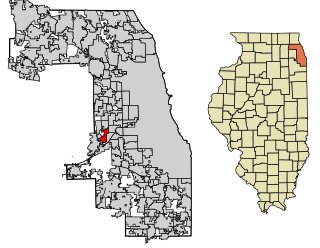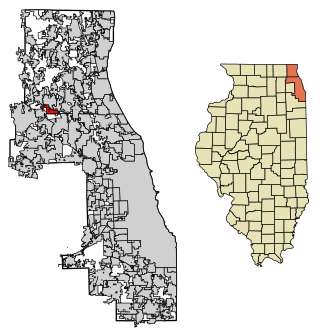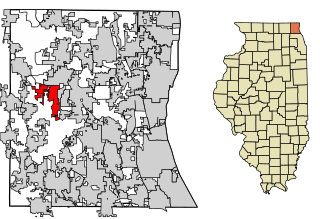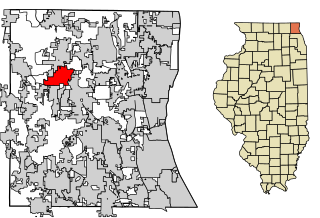
Barrington Hills is a village located about 40 miles (64 km) northwest of Chicago in the U.S. state of Illinois. Per the 2020 census, the population was 4,114. It straddles approximately 29 square miles (75 km2) over four counties, Cook, Kane, Lake, and McHenry. The Village of Barrington Hills was incorporated in 1957.

Countryside is a city in Cook County, Illinois, United States. Per the 2020 census, the population was 6,420.

Deer Park is a village in Lake and Cook Counties, Illinois. Per the 2020 census, the population was 3,681. The village is one of the few left in the Chicago area that enjoy a green belt which is bordered by two large natural areas providing outdoor recreation and open space. The village is home to popular shopping and dining destinations: Deer Park Town Center and the Town Center Promenade. The town is also home to the Vehe Farm, an Illinois Centennial Farm.

Orland Hills is a village in Cook County, Illinois, United States. Per the 2020 census, the population was 6,893.

Sleepy Hollow is a village in Kane County, Illinois, United States. The population was 3,214 at the 2020 census.
Gages Lake is a census-designated place (CDP) in Warren Township, Lake County, Illinois, United States. The population was 10,637 at the 2020 census.
Grandwood Park is a census-designated place (CDP) in Warren Township, Lake County, Illinois, United States. Per the 2020 census, the population was 5,297.

Lake Villa is a village in Lake County, Illinois United States. Per the 2020 census, the population was 8,741. Lake Villa lies within Lake Villa Township and about 50 miles north of Chicago and is part of the United States Census Bureau's Chicago combined statistical area (CSA).

Lakemoor is a village in Lake and McHenry counties in the U.S. state of Illinois. Per the 2020 census, the population was 6,182.

Libertyville is a village in Lake County, Illinois, United States, and a northern suburb of Chicago. It is located 5 miles (8 km) west of Lake Michigan along the Des Plaines River. The 2020 census population was 20,579. It is part of Libertyville Township, which includes the village, neighboring Green Oaks, and portions of Vernon Hills, Mundelein, unincorporated Waukegan and Lake Forest, and part of Knollwood CDP. Libertyville neighbors these communities as well as Gurnee to the north and Grayslake to the northwest. Libertyville is about 40 miles north of the Chicago Loop and is part of the United States Census Bureau's Chicago combined statistical area (CSA).
Long Lake is an unincorporated community and census-designated place (CDP) in Lake County, Illinois, United States. Per the 2020 census, the population was 3,663.

Round Lake is a northern suburb of Chicago in Lake County, Illinois, United States. Per the 2020 census, the population was 18,721.

Round Lake Beach is a northern suburb of Chicago in Lake County, Illinois, United States. Per the 2020 census, the population was 27,252.

Round Lake Park is a village in Lake County, Illinois, United States. Per the 2020 census, the population was 7,680. It is located along the south side of the lake, Round Lake. Access to the lake from this town is private and only for residents of Round Lake Park.
Venetian Village is a census-designated place (CDP) in Lake County, Illinois, United States. Per the 2020 census, the population was 2,761.

Volo is a village in Lake County, Illinois, United States. It was incorporated as a village on April 26, 1993. Per the 2020 census, the population was 6,122.

Wadsworth is a village in Lake County, Illinois, United States. Per the 2020 census, the population was 3,517. It is named after E. S. Wadsworth, who was a major stockholder for the Chicago, Milwaukee, St. Paul and Pacific Railroad, which passes through the village.

Lake in the Hills is a village in McHenry County, Illinois, United States. As of the 2020 census, the population was 28,982.

Lake Villa Township is located in northwestern Lake County, Illinois. The population was 40,276 at the 2010 census.

Warren Township is a township in Lake County, Illinois, USA. As of the 2020 census, its population was 65,883. The cities of Gurnee, Park City, and Grayslake lie within its borders. The township was established in 1850 by settlers who came from the town of Warren, New York. Both were named in honor of Major General Joseph Warren, killed at the Battle of Bunker Hill.




















